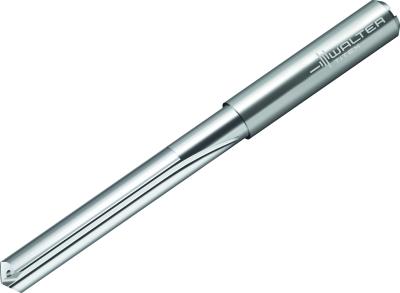
Walter has introduced the DC165 Advance, a family of straight flute solid carbide drills that improve performance, process reliability, tool life, and cutting data in non-ferrous (ISO N) and cast iron (ISO K) applications such as automotive engine blocks, cylinder heads, bed plates, camshaft, gearbox-and clutch housings and chassis parts to name a few; as well as for general metalworking.
They feature four polished margins that provide for less friction, and improve hole quality, surface finish, roundness, and straightness. Their polished clearance angle, relief angle, and flutes yield better wear behavior and better chip evacuation. The new drills are coolant-through, straight flute (G-drills), with emulsion or oil and coolant pressure of 145-580 PSI (10-40 bar). They are offered in cylindrical shank configuration and have a 120° point angle with tolerance of m7. They are also offered in L/D ratio of 5 x Dc as standard, with options for shorter and longer drills to be ordered and specials through Walter’s signature Xpress quotation program.
The Walter lineup of products consists of three categories to tools. Advance which indicates product efficiently balanced between price and performance. Supreme indicates the highest level of technology and performance available and Perform tools are products that provide an economical solution with focused importance on price.
Contact Details
Related Glossary Terms
- clearance
clearance
Space provided behind a tool’s land or relief to prevent rubbing and subsequent premature deterioration of the tool. See land; relief.
- coolant
coolant
Fluid that reduces temperature buildup at the tool/workpiece interface during machining. Normally takes the form of a liquid such as soluble or chemical mixtures (semisynthetic, synthetic) but can be pressurized air or other gas. Because of water’s ability to absorb great quantities of heat, it is widely used as a coolant and vehicle for various cutting compounds, with the water-to-compound ratio varying with the machining task. See cutting fluid; semisynthetic cutting fluid; soluble-oil cutting fluid; synthetic cutting fluid.
- emulsion
emulsion
Suspension of one liquid in another, such as oil in water.
- flutes
flutes
Grooves and spaces in the body of a tool that permit chip removal from, and cutting-fluid application to, the point of cut.
- metalworking
metalworking
Any manufacturing process in which metal is processed or machined such that the workpiece is given a new shape. Broadly defined, the term includes processes such as design and layout, heat-treating, material handling and inspection.
- point angle
point angle
Included angle at the point of a twist drill or similar tool; for general-purpose tools, the point angle is typically 118°.
- relief
relief
Space provided behind the cutting edges to prevent rubbing. Sometimes called primary relief. Secondary relief provides additional space behind primary relief. Relief on end teeth is axial relief; relief on side teeth is peripheral relief.
- shank
shank
Main body of a tool; the portion of a drill or similar end-held tool that fits into a collet, chuck or similar mounting device.
- tolerance
tolerance
Minimum and maximum amount a workpiece dimension is allowed to vary from a set standard and still be acceptable.

